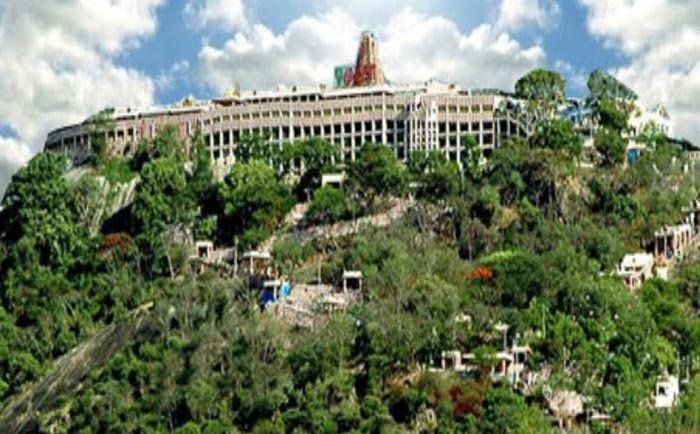Arulmigu Dhandayuthapani Swamy Temple - Palani Murugan Temple

Information of Palani Murugan Temple (Arulmigu Dhandayuthapani Swamy Temple), Dindigul, Tamil Nadu
The Arulmigu Dhandayuthapani Swamy Temple (Palani Murugan Temple) is known to be amongst the six homes of a popular Hindu god called Murugan. The temple is situated in a small town of Pazhani under the Dindigul district in the state of Tamil Nadu. The temple as stated earlier, is dedicated to Lord Murugan. Tonsuring or cutting off hair by the devotees as an act of paying respect to the Lord is deemed to be quite a significant custom with regard to the temple. The temple has also been in news over a controversy related to the idol which is learnt to have been draining or melting out owing to the repetition of customary bathing as well as anointment.
Palani Murugan Temple Religious Significance
The idol of Lord Murugan in the temple is considered to be quite an attraction owing to the traditional belief that it was made and blessed by an eminent sage named Bogar who was also one of the revered Hindu ascetics. The idol is said to have been made with navapashanam or a combination of nine different toxins. A place of worship dedicated to Bhogar can also be found in the corridor on the south-western part of the temple. The combination of the toxins that was used to make the idol is believed to create an undying kind of medicine when mixed up in a particular ratio. Another imperative aspect with regard to the religious factor of this temple is that the idol of the Lord faces towards the west inspite of the east side which is supposed to be opposite to the usual customary direction followed by the Hindu temples at large. The explanation for this aspect has been attributed to the reason of re- sanctifying the temple by the clan of Cheras whose authority rested with the west and the protector of their eastern limit was deemed to be Palani's Lord Kartikeya. The most respected form of adoration is supposed to be the temple's abhishekam referring to the ritual of applying sandalwood paste, unguents, oils and milk on the idol along with bathing in confirmation with the tradition of purification.
Palani Murugan Temple Mythology & History
It is believed according to the mythological facts that the eminent and revered sage Narada at one time had paid a visit to Lord Shiva's divine court in his abode at Mount Kailash with the intent of offering Lord Shiva the "fruit of knowledge" which possessed the magical potion of wisdom. Lord Shiva after receiving it gladly thought of distributing it among his sons Karthikeya and Ganesha by dividing the fruit which was opposed by the sage. This made Shiva decide that the fruit would be given to the one who would be the first to circle the universe thrice. Both the sons agreed to the challenge and commenced their respective journeys. Karthikeya began his journey on the back of his peacock. On the other hand, Ganesha believed that his parents meant the world to him and thus, circled them. Therefore, the fruit was given to Ganesh which made Karthikeya infuriated and left Kailash for settling down in South India's Palani hills.
Palani Murugan Temple Architectural Significance
The Palani Murugan temple was constructed according to the Dravidian architectural pattern on a hill top known as Sivagiri. Although, the temple's sanctum demonstrates a Chera form of architecture however, the covered up passage that surrounds the sanctum bears stark hints relating to Pandya form of architectural designs. The sanctum's walls are known to be filled with carved writings in old Tamil language form. The top of the sanctum includes a decorative tower made of pure gold.
- Andhra Pradesh Temples
- Assam Temples
- Bihar Temples
- New Delhi Temples
- Goa Temples
- Gujarat Temples
- Jammu and Kashmir Temples
- Karnataka Temples
- Kerala Temples
- Madhya Pradesh Temples
- Maharashtra Temples
- Odisha Temples
- Punjab Temples
- Rajasthan Temples
- Sikkim Temples
- Tamil Nadu Temples
- Telangana Temples
- Uttar Pradesh Temples
- Uttarakhand Temples
- West Bengal Temples